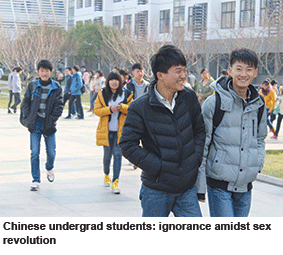 “Sex, sex, sexual intercourse, penis, penis, vagina.” More than 150 undergraduates are sitting in a lecture hall at China Agricultural University in Beijing, shouting loudly. Many are sexually active, or soon will be. Yet for most, it is the first sex education class they have attended.
“Sex, sex, sexual intercourse, penis, penis, vagina.” More than 150 undergraduates are sitting in a lecture hall at China Agricultural University in Beijing, shouting loudly. Many are sexually active, or soon will be. Yet for most, it is the first sex education class they have attended.
Their instructor hopes that shouting such words will help youngsters talk more openly about sex. Lu Zhongbao, a 24-year-old forestry student, says he was told as a child that he “emerged from a rock”. When he started having sex with his university girlfriend, he had little idea about contraception.
It is not just China’s economy that has loosened up since 1979. The country is in the midst of a sexual revolution. A 2012 study found that more than 70 percent of Chinese people have sex before marriage. Other polls put that figure lower but consistently indicate that over the past 30 years, more young Chinese are doing it, with more partners, at a younger age. But lack of sex education means that many are not protecting themselves, resulting in soaring abortion rates and a rise in sexually transmitted diseases.
The Communist Party has stuck its nose into people’s bedrooms for 30 years through its harsh family-planning policies. Yet taboos on sex before marriage prevailed, the result of paternalistic — not religious — values about female chastity, with a dose of Communist asceticism thrown in. Pre-marital sex fell foul of a range of laws, including the catch-all charge of “hooliganism”, only scrapped in 1997.
On the other hand, education on the subject is compulsory in Japan, South Korea and Taiwan — societies that have cultural similarities with China. But as in India, most Chinese schools teach only basic anatomy.
In 2008, the ministry of education included sex education in the national health hygiene curriculum. The barriers are not just prudery. Like football, fashion and other teenage pastimes, sex (and learning about it) is seen as a distraction from studies.
The dominant message is to abstain. A 2013 review by Unesco and Beijing Forestry University noted the prevalence of “terror-based” sex education, with content largely focused on the horrors of pregnancy, abortion and HIV. In early November, a university in Xi’an in central China ran a course entitled ‘No Regrets Youth’ where students received a “commitment card”, essentially a pledge to remain virgin until marriage.
It’s hardly surprising the abortion rate is so high. The one-child policy has made termination a normal phenomenon. Most clinics, private or state, put a premium on speed and offer no advice on how to avoid getting pregnant again.
Marie Stopes, an international reproductive-health agency, reckons that abortions could be as high as 40 million, given domestic sales of pharmaceutical companies selling drugs used in terminations. If that number is correct, around half of all abortions worldwide are in China. The high number of terminations is in marked contrast to the low birth rate. If Marie Stopes is correct, 2.5 babies are aborted in China for every one born, compared with about two live births per termination in Russia and five births to one abortion in America.